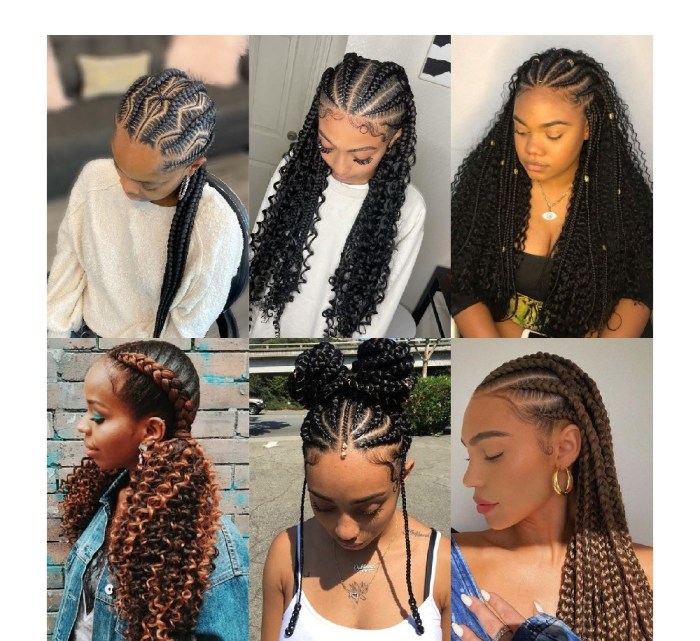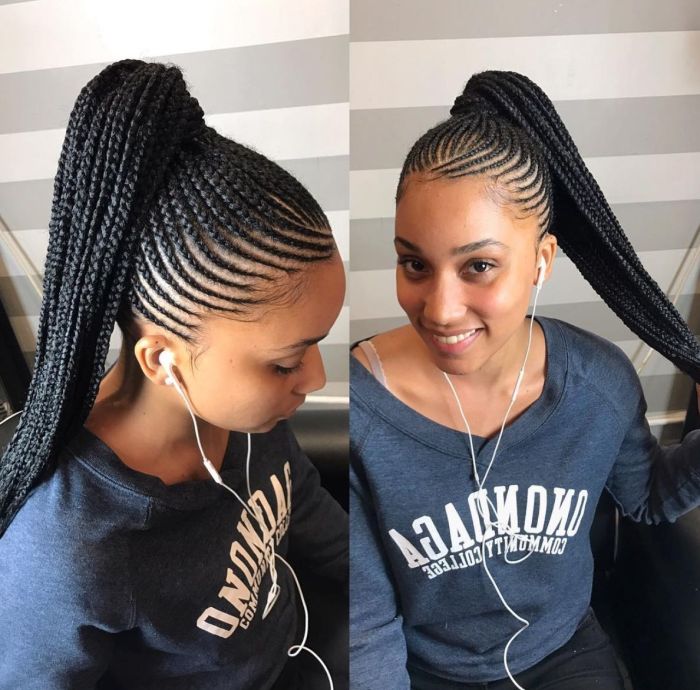Hairstyles Black Hair Braids A Comprehensive Guide
Black Hair Braids: A Comprehensive Guide: Hairstyles Black Hair Braids

Source: curlsqueen.com
Hairstyles black hair braids – Black hair braiding is a rich tradition encompassing diverse styles, cultural significance, and meticulous maintenance. This guide explores the various aspects of black hair braiding, from choosing the right style to ensuring healthy hair practices.
Types of Black Hair Braids

Source: inflexa.com
Numerous braid styles cater to different preferences and occasions. The following table compares five popular choices, considering difficulty, time commitment, maintenance, and styling versatility.
| Braid Style | Difficulty | Time Commitment | Maintenance | Styling Versatility |
|---|---|---|---|---|
| Cornrows | Medium | 2-4 hours | Low | High |
| Box Braids | Medium-High | 4-8 hours | Medium | High |
| Individual Braids | High | 8+ hours | High | Medium |
| Tree Braids | High | 6-10 hours | Medium-High | Medium |
| Ghana Braids | Medium-High | 4-6 hours | Medium | High |
Cornrows, for instance, hold deep cultural significance in many African communities, often representing storytelling, social status, or spiritual beliefs. The intricate patterns woven into the braids can convey complex messages. Box braids, while popularized globally, also have roots in African traditions, serving as both a practical protective style and a means of artistic expression. Finally, individual braids, due to their time-consuming nature and intricate detail, represent a dedication to both style and self-care.
Box braids offer extensive variations. Size ranges from thin, delicate braids to thick, substantial ones. Patterns can be simple and uniform or complex and geometric, incorporating zigzags, curves, or even artistic designs. Adding beads, colorful extensions, or other decorative elements further personalizes the style.
Hair Preparation and Maintenance

Source: thrivenaija.com
Proper hair preparation is crucial for a successful and healthy braiding experience. Maintaining the style requires attention to dryness, itchiness, and scalp health.
- Wash hair with a moisturizing shampoo and conditioner.
- Deep condition to add moisture and strength.
- Detangle hair gently using a wide-tooth comb or your fingers.
- Apply a leave-in conditioner for added moisture.
Maintaining braided styles requires consistent care. Regular moisturizing is key to preventing dryness and breakage.
- Use a moisturizing spray or oil to keep hair hydrated.
- Avoid excessive heat styling.
- Protect hair from the elements (sun, wind, etc.).
- Regularly check for scalp irritation or dryness.
- Consider using a scalp treatment to address any concerns.
Moisturizing and protecting braided hair involves a multi-pronged approach. Direct application of oils, creams, or leave-in conditioners, coupled with protective coverings like satin scarves or bonnets, helps retain moisture and prevent damage.
Braiding Techniques and Tutorials
Cornrowing involves a specific technique to create neat, close-to-the-scalp braids. The following steps Artikel the process.
- Section the hair into small, manageable parts.
- Divide each section into three strands.
- Begin braiding by crossing the right strand over the middle strand.
- Then, cross the left strand over the new middle strand.
- Continue this pattern, adding small sections of hair from the scalp to each strand as you braid.
- Secure the end of the braid with a small elastic band.
Braiding with natural hair versus extensions significantly impacts the process. Natural hair requires careful sectioning and tension management to avoid breakage. Extensions offer greater length and volume, simplifying the process but requiring secure attachment to prevent damage.
Installing box braid extensions involves securing each extension to a small section of natural hair. The process should focus on avoiding excessive tension to prevent scalp damage. This typically involves braiding a small section of natural hair, then attaching the extension by braiding it in with the natural hair. The extension should be securely attached, but not pulled tightly.
Styling Black Hair Braids, Hairstyles black hair braids
Braided hairstyles offer a multitude of styling options, adapting to various occasions and personal preferences.
Black hair braids offer a diverse range of styles, from intricate cornrows to loose, flowing braids. The versatility extends beyond length, as many braided styles work well with medium-length hair. For those considering other options for medium hair, exploring different looks is recommended, and a great resource for inspiration is this helpful guide on hairstyles for mens medium length hair.
Ultimately, the best style depends on personal preference, but both braided styles and other medium-length cuts offer exciting possibilities.
- Updos: High buns, low buns, braided top knots.
- Half-updos: Half-up, half-down styles with various braid placements.
- Accessories: Headbands, scarves, clips, beads.
Box braids offer diverse styling potential. Here are three example hairstyles:
- High bun: Gather all braids into a high bun, securing with an elastic band or bobby pins.
- Side braids: Part hair to one side and braid the box braids into a single large braid down the side.
- Half-up, half-down: Section the top half of the braids and secure them with an elastic band, leaving the bottom half loose.
Styling braids for different occasions involves adjusting the complexity and formality. Formal events might call for elaborate updos, while casual outings could feature simpler styles. Athletic activities necessitate secure styles that won’t interfere with movement.
Hair Health and Concerns
Maintaining braided styles presents potential challenges. Addressing these concerns proactively is crucial for healthy hair.
Common challenges include hair breakage, scalp irritation, and traction alopecia (hair loss due to pulling). Prevention involves avoiding excessive tension during braiding, using gentle detangling techniques, and maintaining a clean scalp. Treatment may involve addressing scalp irritation with gentle cleansers and moisturizing products, or seeking professional advice for more severe cases of traction alopecia.
Regular scalp care is paramount for those wearing braids. This includes gentle cleansing, moisturizing, and monitoring for any signs of irritation or infection. Addressing these issues promptly helps maintain scalp health and prevents long-term hair problems.
Braiding Tools and Products
The right tools and products enhance the braiding experience and promote hair health.
- Rat-tail comb: For precise sectioning.
- Hair clips: To keep sections separate.
- Elastic bands: To secure braids.
- Braiding gel or spray: For hold and shine.
- Moisturizing oil or cream: To prevent dryness.
Braiding hair extensions vary in texture, length, and quality. Synthetic extensions are more affordable but may be less durable. Human hair extensions offer a more natural look and feel but are generally more expensive. Consider the desired style and budget when selecting extensions.
Hair products play a crucial role in the braiding process and aftercare. Products with moisturizing and protective properties help prevent dryness and breakage. However, excessive product buildup can lead to scalp irritation, so moderation is key. Always choose products suitable for your hair type and scalp condition.
Essential Questionnaire
How long do most braided styles last?
The longevity of a braided style depends on the style itself, hair type, and maintenance. Generally, styles can last anywhere from 2-8 weeks.
Can I sleep with wet braids?
It’s best to allow braids to dry completely before sleeping to prevent mold and mildew growth. Sleeping with a satin bonnet or scarf can also help protect your braids.
How often should I wash my scalp while wearing braids?
Washing your scalp every 1-2 weeks, using a gentle cleanser, is recommended to maintain scalp health and prevent build-up.
What are the signs of traction alopecia?
Signs include hair thinning, receding hairlines, and scalp tenderness at the points where braids are tightly pulled. Consult a dermatologist if you suspect this.












